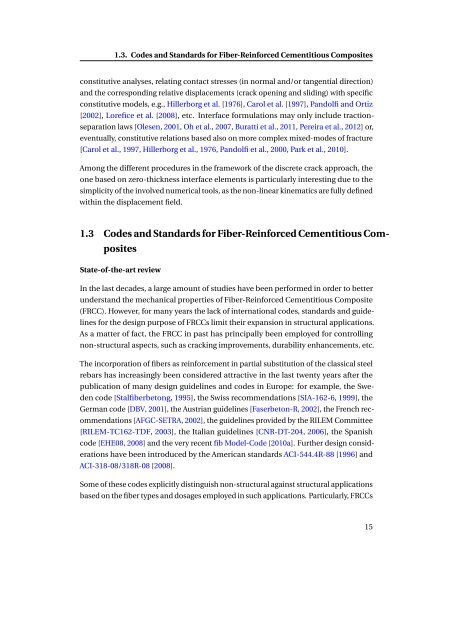tesi A. Caggiano.pdf - EleA@UniSA - Università degli Studi di Salerno
tesi A. Caggiano.pdf - EleA@UniSA - Università degli Studi di Salerno
tesi A. Caggiano.pdf - EleA@UniSA - Università degli Studi di Salerno
- No tags were found...
You also want an ePaper? Increase the reach of your titles
YUMPU automatically turns print PDFs into web optimized ePapers that Google loves.
1.3. Codes and Standards for Fiber-Reinforced Cementitious Compositesconstitutive analyses, relating contact stresses (in normal and/or tangential <strong>di</strong>rection)and the correspon<strong>di</strong>ng relative <strong>di</strong>splacements (crack opening and sli<strong>di</strong>ng) with specificconstitutive models, e.g., Hillerborg et al. [1976], Carol et al. [1997], Pandolfi and Ortiz[2002], Lorefice et al. [2008], etc. Interface formulations may only include tractionseparationlaws [Olesen, 2001, Oh et al., 2007, Buratti et al., 2011, Pereira et al., 2012] or,eventually, constitutive relations based also on more complex mixed-modes of fracture[Carol et al., 1997, Hillerborg et al., 1976, Pandolfi et al., 2000, Park et al., 2010].Among the <strong>di</strong>fferent procedures in the framework of the <strong>di</strong>screte crack approach, theone based on zero-thickness interface elements is particularly interesting due to thesimplicity of the involved numerical tools, as the non-linear kinematics are fully definedwithin the <strong>di</strong>splacement field.1.3 Codes and Standards for Fiber-Reinforced Cementitious CompositesState-of-the-art reviewIn the last decades, a large amount of stu<strong>di</strong>es have been performed in order to betterunderstand the mechanical properties of Fiber-Reinforced Cementitious Composite(FRCC). However, for many years the lack of international codes, standards and guidelinesfor the design purpose of FRCCs limit their expansion in structural applications.As a matter of fact, the FRCC in past has principally been employed for controllingnon-structural aspects, such as cracking improvements, durability enhancements, etc.The incorporation of fibers as reinforcement in partial substitution of the classical steelrebars has increasingly been considered attractive in the last twenty years after thepublication of many design guidelines and codes in Europe: for example, the Swedencode [Stalfiberbetong, 1995], the Swiss recommendations [SIA-162-6, 1999], theGerman code [DBV, 2001], the Austrian guidelines [Faserbeton-R, 2002], the French recommendations[AFGC-SETRA, 2002], the guidelines provided by the RILEM Committee[RILEM-TC162-TDF, 2003], the Italian guidelines [CNR-DT-204, 2006], the Spanishcode [EHE08, 2008] and the very recent fib Model-Code [2010a]. Further design considerationshave been introduced by the American standards ACI-544.4R-88 [1996] andACI-318-08/318R-08 [2008].Some of these codes explicitly <strong>di</strong>stinguish non-structural against structural applicationsbased on the fiber types and dosages employed in such applications. Particularly, FRCCs15
















